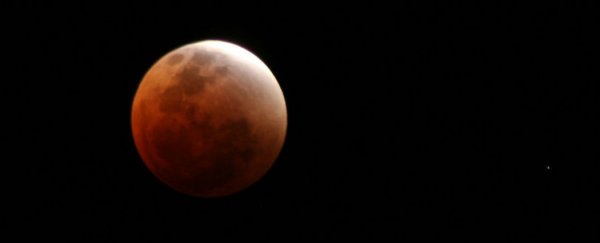Last week, we were lucky enough to experience a solar eclipse, a supermoon, and a Spring equinox, all at once. Well, when I say 'experience', I mean most of us got to watch it online, because the only people who could actually see it were sitting on boats off the coast of the Faroe Islands, and then the Svalbard archipelago.
But that event is just a fraction of the awesomeness we're going to get in our skies this year, with blood moons, meteor showers, and exceptional planet viewings on the ticket for 2015. Mark your calendars accordingly.
April 4 - Total Lunar Eclipse/ Blood Moon. The Moon will past over Earth's dark shadow, or umbra, and take on a dark, and eerie red colour. Totality - when you can see the entire circle of the Moon before it's covered up by shadow again - will last just 9 minutes, which is the shortest duration for a total lunar eclipse since 13 October 1856. It will be visible in most areas of North America, South America, eastern Asia, and Australia.
April 22, 23 - Lyrids Meteor Shower. You'll have the opportunity to see about 20 meteors per hour when this annual shower hits its peak on the evening of April 22 in the northern hemisphere. According to seasky.org, the first quarter Moon will set shortly after midnight, which will leave the night sky dark enough to make this a great meteor-viewing opportunity.
May 5 and 6 - The Eta Aquarids Meteor Shower. If you miss the Lyrids one, don't worry - this one will likely be even more impressive. This annual shower is capable of producing up to 60 meteors per hour. While this one will be more visible to southern hemisphere people, folks in the northern hemisphere might catch a glimpse of it in the wee hours of May 5 and 6.
May 7 - Mercury hits its greatest eastern elongation. This means it'll be positioned 21.2 degrees from the Sun, which makes this the best time of the entire year to view our greyish neighbour, says seasky.org, because "it will be at its highest point above the horizon in the evening sky." They say to look for it low in the western sky just after sunset if you're in the northern hemisphere.
June 6 - Venus hits its greatest eastern elongation. More of a Venus type of person? We get it, who doesn't want to spot this bright white, gaseous minx of a planet? On June 6, it will reach its greatest eastern elongation of 45.4 degrees from the Sun, at which point it'll be at its highest point above the horizon in the night sky just after sunset.
August 12 - Perseid Meteor Shower. "The Perseid meteor shower is usually considered to be among the best of the annual meteor displays thanks to its high rates," says seasky.org. "Lucky observers can sometimes see up to 90 meteors an hour during the shower." Count. Us. In.
August 29 - Full Moon/Supermoon. And we've come full circle, because just like last week, we've got another supermoon. This occurs when the Moon moves into a position that's on the opposite side of Earth to the Sun, which means its face will be fully lit-up, while also making its closest approach to Earth, making it appear larger and brighter. According to seaskyorg, this particular supermoon was known by early Native American tribes as the Full Sturgeon Moon because all the extra light made sturgeon fishing a whole lot easier. View this one at 18:35 UTC.
September 28 - Total Lunar Eclipse. In case you missed the April 4 event, this one has got you covered.
October 20 - The Orionids Meteor Shower. The shower will occur throughout October, but on the night of October 21 and the morning of October 22, it will hit its peak, often delivering around 20 meteors per hour. It's made up of the dust trails left behind by comet Halley.
October 28 - Three-Planet Conjunction. This rare event sees Venus, Mars, and Jupiter form a triangle in the early morning sky. If you're in the northern hemisphere, look to the east, says seasky.org, just before sunrise.
December 25 - Full Moon. What a way to spend Christmas, with a big, bright Moon in the sky to celebrate.
Source: seasky.org
